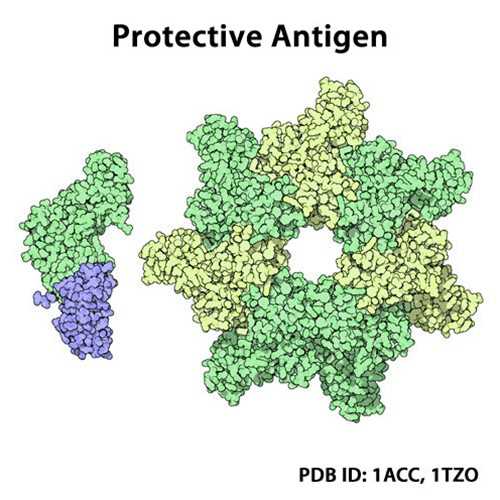Wild-Type PA (Anthrax Protective Antigen (PA))
Wild-type protective antigen (PA).
Anthrax toxin is a three-protein exotoxin secreted by virulent strains of the bacterium, Bacillus anthracis, the causative agent of anthrax. Anthrax toxin is composed of a cell-binding protein, known as protective antigen (PA), and two enzyme components, called edema factor (EF) and lethal factor (LF). Anthrax is caused by B. anthracis, a spore-forming, Gram positive, rod-shaped bacterium. The lethality of the disease is caused by the bacterium's two principal virulence factors: the polyglutamic acid capsule, which is anti-phagocytic, and the tripartite protein toxin, called anthrax toxin.
From the laboratory of Stephen H. Leppla, PhD, National Institute of Allergy and Infectious Diseases/NIH.
Read about how this product was utilized by Absolute Antibody to validate their, Recombinant Engineered Antibodies Against Anthrax.
Wild-type protective antigen (PA).
Anthrax toxin is a three-protein exotoxin secreted by virulent strains of the bacterium, Bacillus anthracis, the causative agent of anthrax. Anthrax toxin is composed of a cell-binding protein, known as protective antigen (PA), and two enzyme components, called edema factor (EF) and lethal factor (LF). Anthrax is caused by B. anthracis, a spore-forming, Gram positive, rod-shaped bacterium. The lethality of the disease is caused by the bacterium's two principal virulence factors: the polyglutamic acid capsule, which is anti-phagocytic, and the tripartite protein toxin, called anthrax toxin.
From the laboratory of Stephen H. Leppla, PhD, National Institute of Allergy and Infectious Diseases/NIH.
Read about how this product was utilized by Absolute Antibody to validate their, Recombinant Engineered Antibodies Against Anthrax.
In order to purchase this product, we require a Letter of Assurance form to be completed. Download form here: ![]() Kerafast Letter of Assurance
Kerafast Letter of Assurance
| Product Type: | Protein |
| Name: | Wild-type |
| Alternative Name(s): | PAWT |
| Accession ID: | P13423 |
| Strain: | Expressed in avirulent engineered B. anthracisstrain BH480 |
| Format: | Purified protein (liquid) |
| Purity: | Hydroxyapatite Chromatography |
| Buffer: | 5 mM Hepes pH 7.5, 0.50 mM EDTA |
| Concentration: | 7.26mg/mL |
| Storage: | -80C |
| Shipped: | Dry ice |
- Leppla SH. Production and purification of anthrax toxin. Methods Enzymol. 1988;165:103-16.
- van Rijn JM, Werner L, Aydemir Y, Spronck JMA, Pode-Shakked B, van Hoesel M, Shimshoni E, Polak-Charcon S, Talmi L, Eren M, Weiss B, H J Houwen R, Barshack I, Somech R, Nieuwenhuis EES, Sagi I, Raas-Rothschild A, Middendorp S, Shouval DS. Enhanced Collagen Deposition in the Duodenum of Patients with Hyaline Fibromatosis Syndrome and Protein Losing Enteropathy. Int J Mol Sci. 2020 Nov 2;21(21):8200. View Article
If you publish research with this product, please let us know so we can cite your paper.


